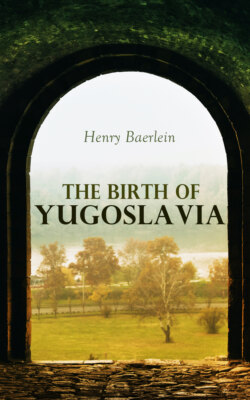Читать книгу The Birth of Yugoslavia - Henry Baerlein - Страница 25
На сайте Литреса книга снята с продажи.
FOOTNOTES:
Оглавление[4] From the word sloviti, to speak—meaning those who can speak to and comprehend one another.
[5] Premrou quotes from the account of this ambassador's journey in the year 965, which was published at Petrograd in 1898.
[6] Cf. Serbia, by L. F. Waring. London, 1917.
[7] The sources of the ancient history of Croatia have been collected by F. Rački in his Documenta historiæ Croaticæ periodum antiquam illustrantia, Zagreb, 1877. Cf. also his well-known and excellent essays in Rad. jugoslav. Akad.; the Poviest Hrvata de Vjekoslav Klaič, Zagreb, 1899–1911, and a short but very good account by F. Sišić in Pregled povijesti hrv. naroda, Zagreb, 1916. I am indebted for these references to Dr. Yovan Radonić, who is regarded as among the first of Croat historians.
[8] This book, dating from 1395, is in the town library of Reims.
[9] "The Bulgarians, in their historical, ethnographical and political frontiers." Text in four languages. Berlin, 1917.
[10] La Macedoine, by Simeon Radeff. Sofia, 1918.
[11] Obzor Chronografov, published by Professor Popov in 1863.
[12] Pester Lloyd, June 21, 1917.
[13] Introduction à l'Histoire de l'Asie. Paris, 1896.
[14] In a monograph on the 600th anniversary of the Church of St. Mary at Celje (Celje, 1910) there is reproduced a contemporary narrative of the funeral of Count Ulrich. After describing how the widow, the noble lady Catharine, had with dire wailing gone round the altar and offered sacrifice, being followed by all the congregation, it proceeds: "Da diss geschehen gieng wieder herfür ein geharnischter Mann, der Namb zu sich Schilt, Helmb, Wappen, legte sich auf die Erden, vnd striche gar lauth, ganz erbärmlich vnd gar Cläglich mit heller stimbe drei mahl nacheinander Graffen zu Cilli, vnd Nimmehr zerreiss die Panier, Zerbrach die Wappen da war Allererst ein Clagen, dass es nicht einen Menschen, sondern ein harten stain hete Erbarmen Mögen."
[15] Cf. A lecture delivered by Sir Arthur Evans before the Royal Geographical Society, January 10, 1916.
[16] Cf. La Fine della Serenissima, by Ricciotti Bratti. Milan, 1919.
[17] Südosteuropäische Fragen, by Hermann Wendel. Berlin, 1918.
[18] His equipment, as M. Charles Loiseau (in Le Balkan Slave et la Crise Autrichienne, Paris, 1898) remarks very truly, "n'est pas banal." One of his historians relates that he was furnished with a sword, a lance, javelins and arrows trimmed with falcons' feathers, sometimes also with a sabre and a small axe. He was garbed in a cloak of wolf's skin, using the same skin for his cap, round which was wound a dark piece of cloth. On his saddle was a scarf of silk. The reins of his horse were gilded, and he carried in his right hand a javelin of iron, gold and silver, weighing 150 lb. (?), and this he balanced on the left side with a large skin of wine. On his back was a magnificent cloak, and behind him there was a folded tent.
[19] Monumenta Serbica, edited by F. Miklosić.
